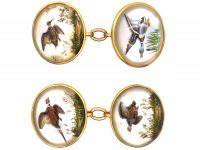-
Your Shopping Bag is empty
A Link to the Past
From gaudy, provocative designs to exquisite examples set in gold and embedded with precious gemstones, cufflinks are a sharp way to add flair to classic formalwear.
Discover More

 Free Worldwide Delivery
Free Worldwide DeliveryA fine pair of rock crystal and 18ct75% pure gold (or 750 parts pure gold and 250 parts other metals) gold cufflinks that were made in England circa 1880-1900. A reverse crystal intaglioAn engraved stone, the opposite of a cameo, with a recessed design cut below the surface of the stone. Intaglio designs are common for signet rings and fob seals. is a rock crystal cabochonA polished, not faceted, dome shaped stone - either round or oval with a flat polished base, primarily used as a cut for phenomenal stones such as cat's eyes and stars.
with an intaglio carved into the flat back. The intaglio was also painted realistically with oils so, that when viewed through the top, the image appears three-dimensional. Finally, the back was sealed in order to preserve the painted areas. The technique originated in Belgium c. 1860 and is attributed to an artist named Emile Marius Pradier. This technique was also practiced in England by Thomas Cook and his descendants who made crystals for Lambeth & Co.
Production of a reverse crystal intaglio begins with the mining and cutting of fine rock crystal from Brazil or Madagascar. A well-formed cabochon is the key to a beautifully made reverse intaglio and the tedious process of hand polishing it to perfection had to be completed before the design work could begin. A watercolour of the image was painted on the underside of the cabochon and an oil and diamondA precious, lustrous gemstone made of highly compressed carbon. Diamonds are one of the hardest materials known to mankind. Colours of diamonds range from colourless, yellow, orange and brown to almost black. Natural coloured (or ‘fancy’) diamonds can be extremely rare. The cut, colour, clarity and carat weight of a diamond are the criteria jewellers use... dust mixture was used along with up to 250 scribing tools to carve the design into the interior of the crystal “…the deeper the carving the more pronounced trompe l’oeil effect.” Once the carving was established the painting process began with extremely fine brushes and paint working in reverse to create incredibly detailed images.
The motifs most commonly found are sporting themes – horses, dogs, foxes and birds. This relatively secret process passed through family members, so keeping it exclusive and expectations of quality were very high. They remained in fashion until poorly made glass and plastic imitations flooded the market c. 1920s.
These rock crystal cufflinks feature a duck, a snipe, a pheasant and a grouse and are highly detailed and in very good condition. The crystal is backed with mother of pearlThe iridescent inner layer of certain molluscs such as oysters or abalones which is used as a decorative inlay.. Cufflinks such as these are very collectable today.
We are pleased to offer FREE SHIPPING on all purchases.
All orders are fully insured and dispatched securely by our trusted partner, DHL Express.
We offer a 30 day, full money-back guarantee on all purchases.
UK - Free, with a pre-paid returns envelope
USA, Europe & Rest of World - Buyer pays for return postage and any taxes/duties applied

From gaudy, provocative designs to exquisite examples set in gold and embedded with precious gemstones, cufflinks are a sharp way to add flair to classic formalwear.
Discover More

We look forward to welcoming you to the AJC Townhouse, our home in the heart of London's Mayfair - and one of London's best kept secrets.
Book Your Appointment
Buying antique jewellery is both ethical and eco-friendly as harmful and destructive mining processes are not needed to make an item yours. So give yourself a pat on the back!
Find Out More


We always stand by our five core principles:
Quality, Rarity, Expertise, Peace of Mind and Personal Touch